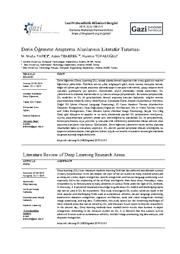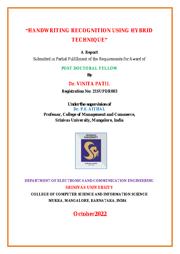A copy of this work was available on the public web and has been preserved in the Wayback Machine. The capture dates from 2016; you can also visit the original URL.
The file type is application/pdf.
Filters
Creating a Handwriting Recognition Corpus for Bushman Languages
[chapter]
2011
Lecture Notes in Computer Science
Handwriting recognition systems rely on the existence of a corpus for training recognition models and evaluating accuracy. ...
To solve this problem, a semi-automatic Web-based tool was developed to segment, capture and encode the Bushman text. ...
Acknowledgements This research is supported by the University of Cape Town, the Telkom/NSN/Telesciences/THRIP Centre of Excellence and the National Research Foundation. ...
doi:10.1007/978-3-642-24826-9_28
fatcat:jcgnuk6pzraoxe37h6gk7bfr4m
A Review on Feature Extraction and Feature Selection for Handwritten Character Recognition
2015
International Journal of Advanced Computer Science and Applications
The development of handwriting character recognition (HCR) is an interesting area in pattern recognition. ...
HCR system consists of a number of stages which are preprocessing, feature extraction, classification and followed by the actual recognition. ...
The off-line character recognition is more complex and requires more research compared to on-line character recognition. ...
doi:10.14569/ijacsa.2015.060230
fatcat:kaevu3rdnvehll5de7phax4u7e
Online and off-line handwriting recognition: a comprehensive survey
2000
IEEE Transactions on Pattern Analysis and Machine Intelligence
Algorithms for preprocessing, character and word recognition, and performance with practical systems are indicated. ...
Both the on-line case (which pertains to the availability of trajectory data during writing) and the off-line case (which pertains to scanned images) are considered. ...
OFF-LINE HANDWRITING RECOGNITION The central tasks in off-line handwriting recognition are character recognition and word recognition. ...
doi:10.1109/34.824821
fatcat:d2pq2n2yhra65cq2h7zzllhctm
Recognition of Tibetan wood block prints with generalized hidden Markov and kernelized modified quadratic distance function
2011
Proceedings of the 2011 Joint Workshop on Multilingual OCR and Analytics for Noisy Unstructured Text Data - MOCR_AND '11
First, it incorporates a language model into our recognition system which in turn enforces grammar and disambiguates classification errors caused by printing errors and image noise. ...
For features of our emission model we apply line and circle Hough transform to stroke detection, and use classspecific scaling for feature weighing. ...
HMM-based approaches and holistic approaches have also been a common trend in Arabic and Persian off-line handwriting recognition systems [11] [19] . ...
doi:10.1145/2034617.2034631
fatcat:mtlsi3v4ifbzdmqfmqq3a76v5y
A novel approach for structural feature extraction: Contour vs. direction
2004
Pattern Recognition Letters
The paper presents a novel approach for extracting structural features from segmented cursive handwriting. The proposed approach is based on the contour code and stroke direction. ...
The direction feature identifies individual line segments or strokes from the character's outer boundary or thinned representation and highlights each character's pertinent direction information. ...
Off-line handwriting recognition refers to the problem of computer-based reading of handwritten characters or words that have been written on a common surface (i.e. paper). ...
doi:10.1016/j.patrec.2004.02.013
fatcat:2ij5tj7aorgqljfbnkgb7avlwy
A Genetic-LVQ neural networks approach for handwritten Arabic character recognition
2018
Artificial intelligence research
In this paper we present a novel Arabic character handwritten recognition system based on a hybrid method consisting of a genetic algorithm and a Learning vector quantization (LVQ) neural network. ...
Many smart devices available in the market such as pen-based computers, tablets, mobiles with handwritten recognition technology need to rely on efficient handwritten recognition systems. ...
ACKNOWLEDGEMENTS This research project was supported by a grant from the "Research Centre of the Female Scientific and Medical Colleges", Deanship of Scientific Research, King Saud University. ...
doi:10.5430/air.v7n2p43
fatcat:6pyc77bmfncfpgctzyrwseu45u
Derin Öğrenme Araştırma Alanlarının Literatür Taraması
2019
Gazi Mühendislik Bilimleri Dergisi
In the last decade, the-state-of-the-art studies on many research areas such as computer vision, object recognition, speech recognition, and natural language processing were especially led to the awakening ...
, voice and video recognition, medical image processing, and big data. ...
Kosmala, "A systematic comparison between on-line and off-line methods for signature verification with hidden Markov models," in Proceedings. ...
doi:10.30855/gmbd.2019.03.01
fatcat:2sv7dg7elrfqppcjx5otzmb7pi
On-Line Sketch Recognition Using Direction Feature
[chapter]
2013
Lecture Notes in Computer Science
This paper presents an on-line sketch recognition method based on the direction feature. We also present two feature representations to train a classifier. ...
A recognition rate of 97.95% is achieved, and average runtime is 97.6ms using a Support Vector Machine classifier. ...
The database comes from 34 different writers and it is commonly used for on-line symbol recognition, but off-line data is also available. ...
doi:10.1007/978-3-642-40477-1_16
fatcat:u7suychgsjbu5fzrpguxfdk3f4
A Study on Optical Character Recognition Techniques
2017
International Journal of Computational Science Information Technology and Control Engineering
Optical Character Recognition (OCR) is the process which enables a system to without human intervention identifies the scripts or alphabets written into the users' verbal communication. ...
Earlier exploration going on Optical Character detection or recognition has shown that the In Handwritten text there is no limitation lying on the script technique. ...
Typically, there are two dissimilar categories of handwriting character detection: off-queue and on-queue. ...
doi:10.5121/ijcsitce.2017.4101
fatcat:tvyygemmeng7hl7i34w5w34xnm
Efficient Design of Hardware-Enabled Reservoir Computing in FPGAs
[article]
2018
arXiv
pre-print
We confirm the validity of those principles building reservoir computing hardware based on a field-programmable gate array. ...
The combination of both methods and the resulting reduction of time required for performance optimization of a hardware system establish a strategy towards machine learning hardware capable of self-adaption ...
ANR-11-LABX-0001-01) and by the BiPhoProc ANR project (ANR-14-OHRI-0002-02). ...
arXiv:1805.03033v1
fatcat:hunx4rn3dveu7meluo5wvuolli
HANDWRITING RECOGNITION USING HYBRID .TECHNIQUE
2023
Zenodo
Off-line handwriting recognition is the process to translate digital image of handwritten text into machine editable text. ...
develop an off-line character recognition system. Two different recognition networks can build namely Adaptive MLP classifier without feature reduction and Adaptive MLP classifier with feature reduction ...
Sample MNIST dataset In general pre-processing plays a significant role in CNN based handwritten recognition process. ...
doi:10.5281/zenodo.7578725
fatcat:dphdiz7khzan3bcwqegzfiugwa
Training of deep neural networks for the generation of dynamic movement primitives
2020
Neural Networks
While the developed approach is applicable to any neural network architecture, it was evaluated on two different architectures based on encoder-decoder networks and convolutional neural networks. ...
The parameters of our neural networks are computed off-line and do not need to be estimated during the real robot operation. ...
Such network architectures contain fewer but properly organized parameters that can be trained more easily while retaining the expressive power for visual recognition tasks. ...
doi:10.1016/j.neunet.2020.04.010
pmid:32339807
fatcat:6sfpdtpfkreldi3ut4rbsvjvse
Towards Practicality of Sketch-Based Visual Understanding
[article]
2022
arXiv
pre-print
However, sketches are highly abstract and subjective based on the perception of individuals. ...
Sketches have been used to conceptualise and depict visual objects from pre-historic times. ...
On the other side, rasterization converts sketch vector to sketch image (c), and provides an encoding for vector-based recognition tasks downstream (d). . . . . . . ...
arXiv:2210.15146v1
fatcat:4q6tebhstbe3pilzbsd45pjtw4
Visual Learning by Coevolutionary Feature Synthesis
2005
IEEE Transactions on Systems Man and Cybernetics Part B (Cybernetics)
The method uses linear genetic programming to encode potential solutions expressed in terms of elementary operations, and handles the complexity of the learning task by applying cooperative coevolution ...
The task addressed here concerns data-driven synthesis of recognition procedures for real-world object recognition task. ...
Acknowledgements We would like to thank the authors of software packages: ECJ (Luke, 2002) and WEKA (Witten & Frank, 1999) for making their software publicly available. ...
doi:10.1109/tsmcb.2005.846644
pmid:15971911
fatcat:e2ji56ovl5bszclhqsbnhhukvm
MetaHTR: Towards Writer-Adaptive Handwritten Text Recognition
[article]
2021
arXiv
pre-print
We discover and leverage on the important insight that there exists few key characters per writer that exhibit relatively larger style discrepancies. ...
In this paper, we take a completely different perspective -- we work on the assumption that there is always a new style that is drastically different, and that we will only have very limited data during ...
A naive approach would be using traditional crossentropy loss [40] , which usually trains any attentionaldecoder based text recognition system, for both inner (Eqn. 2) and outer loop (Eqn. 3). ...
arXiv:2104.01876v1
fatcat:y5axhbygmnfd7c7iofo5w6bvxu
« Previous
Showing results 1 — 15 out of 593 results















